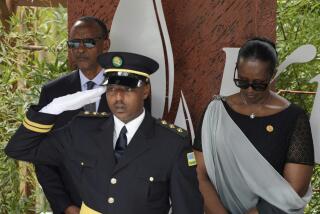Still haunted by the killing
“I wish I could turn back right now,” retired Canadian Lt. Gen. Romeo Dallaire says meaningfully as he looks out the airplane window. “To me it seems like going back into hell.” By the end of “Shake Hands With the Devil,” the compelling, overwhelming documentary record of that journey (which won a deserved audience award at Sundance), no one could fail to understand why.
The general is returning to the African country of Rwanda in 2004 after an absence of 10 years. He’s returning to the scene of one of the most nightmarish crimes of modern times, the massacre of 800,000 Rwandans in roughly 100 days, events that inspired the Oscar-nominated “Hotel Rwanda” and HBO’s stark “Sometimes in April.” The reality, however, is more mesmerizing than any fiction could be.
Dallaire was hardly a bystander during those 1994 events. He was the commander of the U.N. assistance mission to Rwanda, the general in charge of trying to keep the peace, the man Nick Nolte’s “Hotel Rwanda” character is based on. How and why Dallaire was prevented from doing that job is a powerful, chilling case study in what can happen to a man who tries to do the right thing by standing up to absolute evil, who is forced to shake hands with the devil.
As the general is driven into town from the airport at the capital city of Kigali, we hear his memories of “so many bodies we couldn’t pick them up, howling dogs, the smell of death.” We see, as happens periodically throughout the film, brief newsreel footage of corpses and even murders.
But the most troubling aspect of “Devil,” directed by Peter Raymont, is not what we see -- it’s what we hear about what one observer calls “the incredible moral default on the part of the world” that allowed all this to take place. As U.N. special envoy Stephen Lewis puts it, the question is: “Are all humans human, or are some more human than others?”
When Dallaire first got to Rwanda, things looked somewhat promising. The U.N. was on the scene to help implement a peace agreement between the Hutu government and Tutsi rebels. But it soon became apparent that there was a third group, an extremist Hutu militia called Interahamwe, that was biding its time for a chance to inflict maximum carnage on Tutsis and moderate Hutus.
Though Dallaire’s force was small, he had large aims for it. He saw a chance to raid and capture the militia’s arms depots, something that would have crippled the massacre before it got started. The U.N., however, in the first of several moves that look scandalous in the light of history, forbade the action out of fear of repercussions.
The actions Dallaire was able to take are said to have saved thousands of lives, but being reduced, essentially, to the role of bystander as Rwanda’s nightmare unfolded wreaked havoc with the general’s life.
Though almost all observers insist he did all he could, his sense of responsibility haunted him even after he left the country, leading to suicide attempts, hospitalization for post-traumatic stress disorder and continual medication. “It’s as if,” he writes in his book, “someone has sliced into my brain and grafted this horror called Rwanda frame by blood-soaked frame directly on my cortex.”
“Shake Hands With the Devil” explains what happened in 1994 and shows what Dallaire goes through as he revisits the awful scenes of his past. No matter how many people, including the country’s president and former Tutsi rebel leader Paul Kagame, tell him he did all he could, he remains a haunted man.
Dallaire is not only the protagonist of “Shake Hands,” he is a compelling reason to see it. A man of unmistakable honesty and integrity, a career soldier with a penchant for telling the truth, he’s more plain-spoken military man than lofty intellectual. But when it came down to it, when things that really mattered were on the line, what he thought and how he acted put many of the international community’s nominally brightest lights to shame.
*
‘Shake Hands With the Devil’
No MPAA rating
Times guidelines: Shots of corpses and individuals being killed
Released by California Newsreel. Director Peter Raymont. Producers Peter Raymont and Lindalee Tracey. Cinematographer John Westheuser. Editor Michele Hozer. Music Mark Korven. Running time: 1 hour, 31 minutes. Nuart Theatre, 11272 Santa Monica Blvd., West Los Angeles. (310) 281-8223.
More to Read
Only good movies
Get the Indie Focus newsletter, Mark Olsen's weekly guide to the world of cinema.
You may occasionally receive promotional content from the Los Angeles Times.










